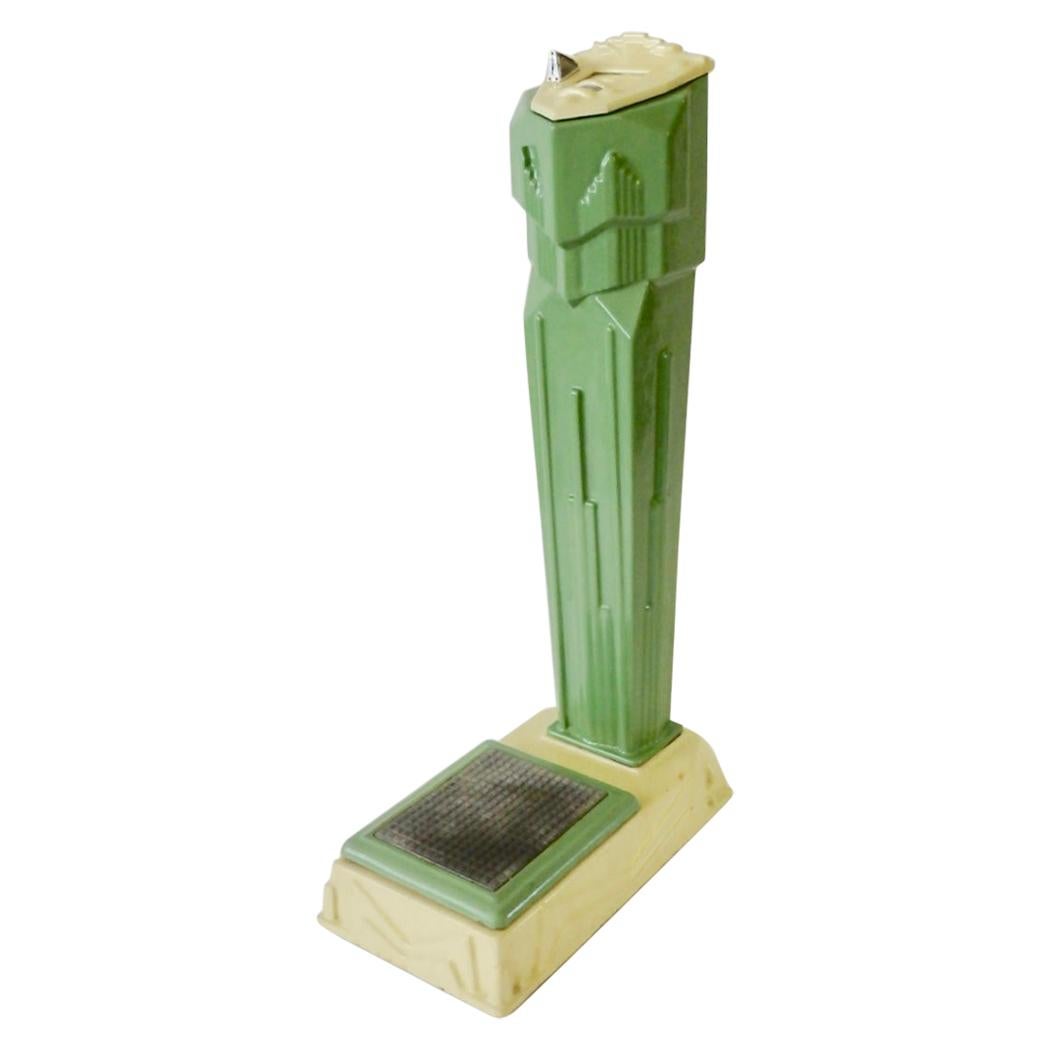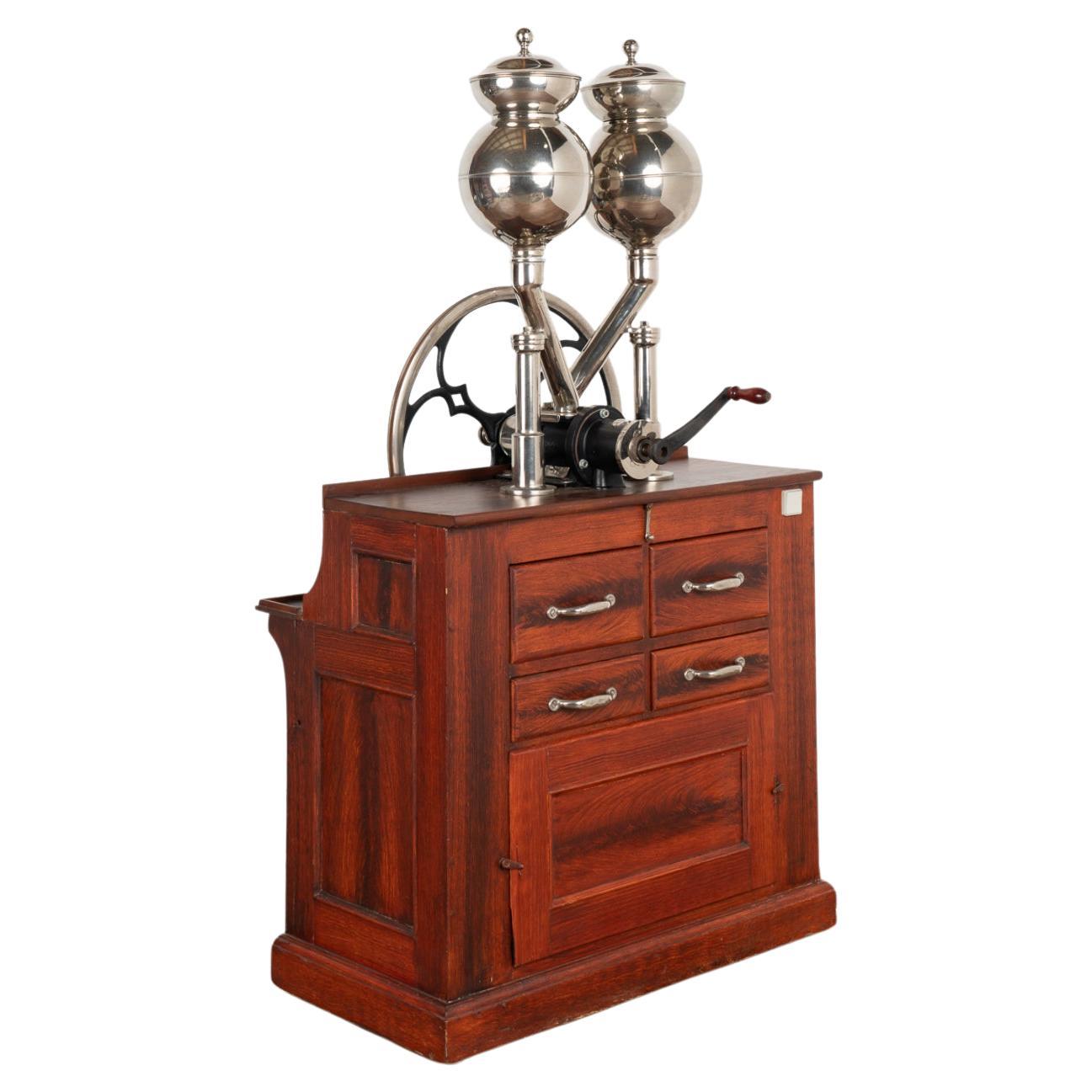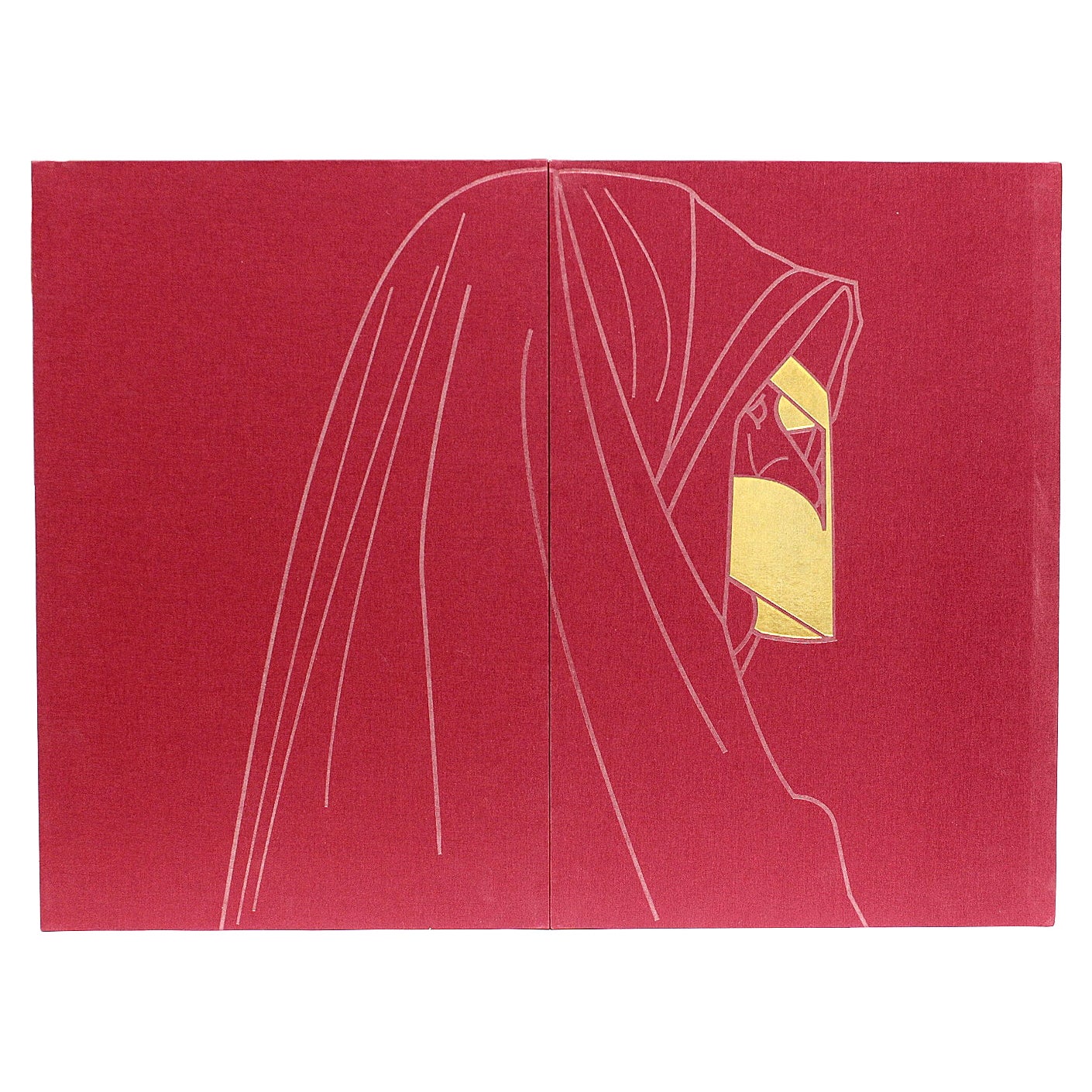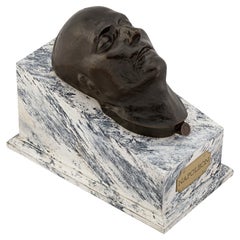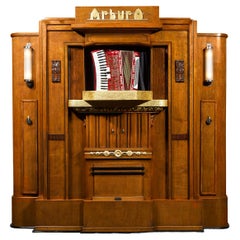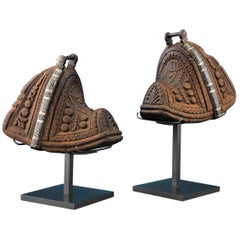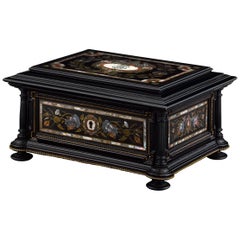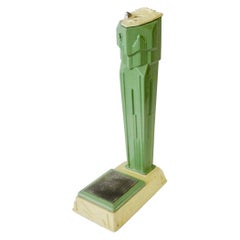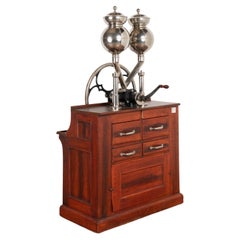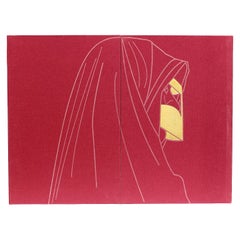Items Similar to The Mills Double Deluxe Violano Virtuoso
Want more images or videos?
Request additional images or videos from the seller
1 of 9
The Mills Double Deluxe Violano Virtuoso
About the Item
One of only a handful ever made, this Double DeLuxe Violano Virtuoso, created by the Mills Novelty Company, is an extremely rare example of American musical automata, featuring not one, but two brilliantly tuned violins. Singled out by the U.S. government in 1909 as one of the eight greatest inventions of the decade when it was introduced at the Alaska Yukon Pacific Exposition, the Mills DeLuxe Violano-Virtuoso stands as one of the most important and incredible musical devices ever made. The “Double Mills,” as it was nicknamed, plays classical, operatic and popular music. It can play on a single or up to 15 nickels and has the ability to run for approximately an hour. It produces exceptional sound with a crisp tonal quality and melodious notes. Housed in a beautiful quarter-sawn oak case, each violin produces 64 notes and is accompanied by a 44-note piano.
It is truly rare to find a historical musical mechanism so complete, with such remarkable sound quality and in excellent condition. This particular Violano has been updated with a digital player system that allows song selections to be made over a WiFi connection. This gives the user a choice between digital downloads or traditional paper rolls for added convenience.
Perfected and patented in 1912 by Henry K. Sandell, the Violano-Virtuoso was produced in limited quantities until 1929 and could be found in the very finest restaurants, hotels and oceanliners. In fact, the Violano-Virtuoso was one of the few American-made mechanical musical devices to be distributed worldwide to the most exclusive international clientele.
The below testimonial was sent to the Mills Company by the Governor of Idaho, aptly describing the incredible music produced by the Violano-Virtuoso.
Dear Sir, Have just had the pleasure of listening to your wonderful Automatic Violin and Piano on exhibition at the Government Building here. This marvelous instrument certainly far surpasses anything that I have eve heard in automatic music. The tone and expression of the violin and the piano are so perfect and clear that is really hard to believe but that there is the human hand playing..."
Indeed, for the price of a nickel, the Mills Violano-Virtuoso delivered a wide variety of musical entertainment ranging from classical operatic arrangements to the popular tunes of the day. Using rolls of perforated paper in much the same way as a player piano, it could play music on either the violins, the piano or both, offering an unparalleled combination of sound. The violins vary from the usual in that they have no fingerboard. Instead, a small metal “finger” rises from under the string lifting it in a “V” shaped slot thus stopping off the string. The strings are bowed by four small wheels made of discs of celluloid clamped together, applying just the right amount of pressure to the strings. These are driven by a delicate variable speed controlled motor to vary the volume of sound produced. The vibrato is produced by shaking the tailpiece of the violin with a series of pneumatic pistons operated by a vacuum pump. The frame of the piano is shield shaped, supporting the bass strings in the center and the treble strings on either side, which evens the stress on the frame and assists in maintaining the piano's tuning.
Up to 15 coins could be accommodated and, depending on the number of songs on each of the music rolls, the Violano-Virtuoso could play for up to an hour. De Luxe Violano-Virtuoso machines of this caliber and condition, retaining such a superb tonal quality, are extremely rare today.
A similar Mills Novelty Company DeLuxe Violano Virtuoso is featured in Q. David Bowers' Encyclopedia of Automatic Musical Instruments on page 520,
circa 1920
Measures: 49 3/8" wide x 34 3/4" deep x 68 1/2" high.
- Creator:Mills Novelty Company (Maker)
- Dimensions:Height: 68.5 in (173.99 cm)Width: 49.38 in (125.43 cm)Depth: 34.75 in (88.27 cm)
- Style:Art Deco (Of the Period)
- Materials and Techniques:
- Place of Origin:
- Period:
- Date of Manufacture:circa 1920
- Condition:Additions or alterations made to the original: General Maintance and upkeep. Fitted electronic Midi player added.
- Seller Location:New Orleans, LA
- Reference Number:Seller: 30-52451stDibs: LU891122598542
About the Seller
5.0
Recognized Seller
These prestigious sellers are industry leaders and represent the highest echelon for item quality and design.
Established in 1912
1stDibs seller since 2010
105 sales on 1stDibs
Typical response time: 11 hours
- ShippingRetrieving quote...Shipping from: New Orleans, LA
- Return Policy
Authenticity Guarantee
In the unlikely event there’s an issue with an item’s authenticity, contact us within 1 year for a full refund. DetailsMoney-Back Guarantee
If your item is not as described, is damaged in transit, or does not arrive, contact us within 7 days for a full refund. Details24-Hour Cancellation
You have a 24-hour grace period in which to reconsider your purchase, with no questions asked.Vetted Professional Sellers
Our world-class sellers must adhere to strict standards for service and quality, maintaining the integrity of our listings.Price-Match Guarantee
If you find that a seller listed the same item for a lower price elsewhere, we’ll match it.Trusted Global Delivery
Our best-in-class carrier network provides specialized shipping options worldwide, including custom delivery.More From This Seller
View AllBronze Napoleon I Death Mask, From The Dr. Antommarchi Cast
Located in New Orleans, LA
This mesmerizing antique bronze death mask of the Emperor Napoleon I is cast from the mold created by Dr. Francesco Antommarchi, Napoleon’s personal physician and companion during th...
Category
Antique 19th Century French Historical Memorabilia
Materials
Bronze
Arburo Orchestrion Organ By Bursens And Roels
By Arburo
Located in New Orleans, LA
Once a fixture in bustling dance halls, cafés and fairgrounds throughout Belgium and the Netherlands in early to mid-20th century, this incredibly rare, early Orchestrion organ is a masterpiece of automated music. Crafted by the Arburo firm run by Arthur Bursens and Gustav Roels, this mechanical marvel is essentially an entire band set within an elegantly constructed Art Deco cabinet. No two Orchestrions were ever created alike and each was made-to-order, one at a time. Each was crafted entirely by hand, even down to the paper music rolls...
Category
20th Century Belgian Art Deco Musical Instruments
Materials
Wood
19th Century Chilean Huaso Stirrups
Located in New Orleans, LA
This striking and rare pair of Chilean wooden stirrups are true gems. Also known as estribos, these stirrups are carved from a solid block of wood. Tak...
Category
Antique 19th Century Chilean Other Arms, Armor and Weapons
Materials
Silver, Steel
Musical Jewelry and Sewing Casket
Located in New Orleans, LA
This charming musical jewelry and sewing box is a work of sublime artistry. Almost certainly German or Austrian in origin and crafted of deep, ebonized...
Category
Early 20th Century Austrian Other Decorative Boxes
Materials
Multi-gemstone
Queen Victoria and Prince Albert Stonemason's Mallet
Located in New Orleans, LA
This exceptional and one-of-a-kind wooden mallet commemorates the marriage of Queen Victoria and Prince Albert, which occurred on February 10, 1840. Exqu...
Category
Antique 19th Century English Victorian Historical Memorabilia
Materials
Wood
Revolutionary War Powder Horn
Located in New Orleans, LA
Powder Horn
Engraving by Charles Goodrich
1776
Powder horns stand among the rarest and most treasured forms of American folk art. Unlike commercial objects, these deeply personal items were crafted by soldiers, sailors and explorers for practical use during their journeys. Through scrimshaw—an intricate technique of engraving bone or horn with a simple jackknife and filling the crevices with available pigments like soot or ash—these individuals left tangible marks of their hopes, dreams and experiences. This exceptional American Revolutionary War powder horn belonged to Charles Goodrich (1720-1816), a significant figure in early Pittsfield, Massachusetts history. The horn displays distinctive period characteristics with the inscription "PITTSFIELD" clearly visible on its amber-colored surface.
Charles Goodrich, born in Wethersfield, Connecticut in 1720, became a prominent civic leader in Pittsfield. He built the first house in the settlement in 1754 and served in various official roles, including Justice of the Peace and town representative to Boston. While Goodrich's name may not appear prominently in history textbooks, historical documents—particularly his September 3, 1776 petition to the Massachusetts Assembly—reveal his compelling story. The petition shows that Goodrich faced accusations of being a British sympathizer and draft evader. According to his account, he was targeted for his public office, physically assaulted by a man named James Morey and subsequently fined by a local committee. Goodrich maintained that he merely defended himself when attacked and claimed ignorance of requirements to either serve as a drafted soldier or hire a substitute—accusations that branded him unpatriotic during the revolutionary fervor.
The Massachusetts Council's concurrence with Goodrich's petition likely inspired his subsequent military service. His powder horn, bearing the inscription of Pittsfield, accompanied him to Fort Ticonderoga, where Simonds' Regiment of Militia (2nd Berkshire County Regiment) was stationed during the difficult winter of 1776-1777. Fort Ticonderoga, a strategic stronghold in upstate New York, had been seized from the British in May 1775 by Ethan Allen and Benedict Arnold. By the time of Goodrich's service, American forces occupied the fort while preparing for an expected British counterattack. In August 1777, Goodrich and Simonds' Regiment participated in the Battle of Bennington—a decisive engagement where Patriot forces under General John Stark defeated British and Hessian troops. This victory significantly weakened General John Burgoyne's invasion force, contributing to his surrender at Saratoga in October 1777—a pivotal turning point that helped secure French support for the American cause.
Powder horns captivate elite collectors and major museums alike. The Metropolitan Museum of Art recognized their significance by dedicating an entire exhibition to American Engraved Powder Horns...
Category
Antique 18th Century American American Colonial Historical Memorabilia
Materials
Horn
You May Also Like
Mills Novelty Co. owl strength lifter “Mills Perfect Muscle Developer”
By Mills Novelty Company
Located in London, GB
Mills Novelty Co. owl strength lifter “Mills Perfect Muscle Developer” Chicago, circa 1905.
Coin operated with an old bronze penny.
Dial marked:
TEST YOUR STRENGTH - THE ARROW...
Category
Early 20th Century American Games
Materials
Brass, Iron
Mills Novelty Art Deco Green Porcelain Penny Scale
By Mills Novelty Company
Located in Ferndale, MI
Art Deco period penny scale by Mills Novelty co. Period green porcelain pedestal with cream colored foot hold.
Category
Vintage 1940s American Art Deco Scientific Instruments
Materials
Iron
$700 Sale Price
41% Off
Vintage Industrial Double Coffee Mill, Copenhagen Denmark circa 1920-40
Located in Round Top, TX
Double coffee mill with motor, two funnels, mill wheel made of iron.
Plaque reads: Frigangs-Kaffemolle; A.Jørgensens & Co. (of Copenhagen, Denmark).
Lower part of red painted wood ...
Category
Mid-20th Century Danish Historical Memorabilia
Materials
Metal, Iron
Moukarzel, Roger - Le Voile: the Journey of the Veil - Deluxe Portfolio Edition
Located in Hillsborough, NJ
Author: Moukarzel, Roger.
Title: Le Voile: The Journey of the Veil. 12-25 December, 2007.
Publisher: Abu Dhabi Music and Arts Foundation (ADMAF), 2007.
Description: Deluxe portfolio edition. 2-1/4" x 23-3/4" x 17-3/4", ten colored photographs (22-1/4" x 16-1/4"), each signed by Moukarzel in print. In the original maroon cloth bound portfolio with the book (text in English and Arabic), and veil.
Condition: Like new
Additional information: Roger Moukarzel is an internationally published documentary and fashion photographer. Born in Beirut in 1962, Moukarzel’s interest in war photography began when he was a teenager. For fifteen years, he worked for news agencies Sygma and Reuters, photographing the essence of combat and the resilience of humanity under the harshest circumstances.
Moukarzel’s photo-documentaries have been featured in many international publications. France’s legendary Paris Match printed one of his photographs – a scene of destruction and mayhem on a Beirut street – on the cover of its 40th anniversary issue.
Years spent documenting turmoil and disaster took a mental and physical toll on Moukarzel. He eventually shifted to fashion photography, a more glamorous (and less dangerous) field. In his own words, he explains: "A shift from scenes of death… to scenes of life A shift from the ugly face of war...
Category
Early 2000s Emirian Books
Materials
Fabric
Architecture of the Old South: Louisiana by Mills Lane
Located in valatie, NY
Architecture of the Old South: Louisiana by Mills Lane. New York: A Beehive Press book or Abbeville Press, 1990. First edition hardcover with dust jacket. 203 pp. The book has chapters on: The Colony, Federal Era...
Category
1990s American Books
Materials
Paper
Rubáiyát of Omar Khayyám – The Elihu VEDDER, SUPER DELUXE Edition
Located in Middletown, NY
A lavish production and VEDDER's MASTERPIECE, The Rubaiyat was a great success and helped establish Vedder as a major American artist.
Khayyám, Omar / Illustrated by ELIHU VEDDER / ...
Category
Antique Late 19th Century American Books
Materials
Gold Leaf

